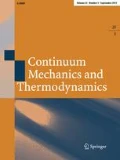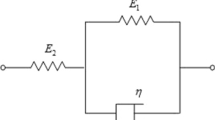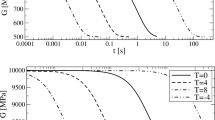Abstract
The homogenization of viscoelastic composite materials gives rise to long-memory effects, reflected by the presence in the homogenized viscoelastic constitutive law of a delayed stress response expressed as a convolution integral involving the past material strain history. Computations reveal that the long-memory has the ability to delay or even absorb waves depending on the fraction of reinforcement and relative properties of the building phases with the composite. An approximation by a one-term Prony series of the computed spectrum of retardation times is shown to provide an accurate representation of the continuous spectrum of retardation times when simulating creep experiments. The long-memory effects entail shifts of the frequency band diagrams for both the natural and damped frequencies due to the presence of damping. Decreasing the effective retardation time of the composite leads to a faster attenuation of propagating longitudinal and shear waves.













Similar content being viewed by others
References
Abdessamad, Z., Kostin, I., Panasenko, G., Smyshlyaev, V.P.: Memory effect in homogenization of a viscoelastic Kelvin-Voigt model with time-dependent coefficients. Math. Mod. Methods Appl. Sci. 19(09), 1603–1630 (2009)
Bercoff, J., Tanter, M., Fink, M.: Supersonic shear imaging: a new technique for soft tissue elasticity mapping. IEEE Trans. Ultrason. Ferroelectr. Freq. Control 51(4), 396–409 (2004)
Chaudhuri, O.: Viscoelastic hydrogels for 3D cell culture. Biomater. Sci. 5(8), 1480–1490 (2017)
Cherraf-Schweyer, C., Maurice, G., Taghite, M., Taous, K.: Periodic homogenization in viscoelasticity. Influence of micro mechanical parameters on the homogenized memory law: numerical tests. ZAMM J. Appl. Math. Mech./Z. Angew. Math. Mech. Appl. Math. Mech. 87(3), 235–246 (2007)
Christensen, R.M.: Viscoelastic properties of heterogeneous media. J. Mech. Phys. Solids 17(1), 23–41 (1969)
Cowin, S.C.: How is a tissue built? J. Biomech. Eng. 122(6), 553–569 (2000)
Daridon, L., Licht, C., Orankitjaroen, S., Pagano, S.: Periodic homogenization for Kelvin–Voigt viscoelastic media with a Kelvin–Voigt viscoelastic interphase. Eur. J. Mech.-A/Solids 58, 163–171 (2016)
Del Toro, R., Bacigalupo, A., Paggi, M.: Characterization of wave propagation in periodic viscoelastic materials via asymptotic-variational homogenization. Int. J. Solids Struct. 172, 110–146 (2019)
DeWall, R.J., Slane, L.C., Lee, K.S., Thelen, D.G.: Spatial variations in Achilles tendon shear wave speed. J. Biomech. 47(11), 2685–2692 (2014)
Francfort, G., Leguillon, D., Suquet, P.: Homogenization for linearly viscoelastic bodies. Comptes Rendus De L’Académie Des Sciences Série I-Mathématique 296(5), 287–290 (1983)
Francfort, G.A., Suquet, P.M.: Homogenization and mechanical dissipation in thermoviscoelasticity. Arch. Ration. Mech. Anal. 96(3), 265–293 (1986)
Fung, Y.C.: Biomechanics. Mechanical Properties of Livingtissues. Springer, Berlin (1993)
Ganghoffer, J.F., Laurent, C., Maurice, G., Rahouadj, R., Wang, X.: Nonlinear viscous behavior of the tendon’s fascicles from the homogenization of viscoelastic collagen fibers. Eur. J. Mech.-A/Solids 59, 265–279 (2016)
Greenleaf, J.F., Fatemi, M., Insana, M.: Selected methods for imaging elastic properties of biological tissues. Annu. Rev. Biomed. Eng. 5(1), 57–78 (2003)
Gründemann, H., Sanchez-Palencia, E.: Homogenization techniques for composite media. In: Proceedings, Udine, Italy 1985, vol. ix. Springer-Verlag, Berlin. etc., p. 397 dm 73,d. isbn 3-540-17616-0 (lecture notes in physics 272), ZAMM J. Appl. Math. Mech./Z. Angew. Math. Mech. 68(6) (1988) 212–212 (1987)
Hashin, Z.: Viscoelastic behavior of heterogeneous media. J. Appl. Mech. 32(3), 630–636 (1965)
He, L.H., Lim, C.W.: Time-dependent interfacial sliding in fiber composites under longitudinal shear. Compos. Sci. Technol. 61(4), 579–584 (2001)
Hine, P.J., Gusev, A.A.: Validating a micromechanical modelling scheme for predicting the five independent viscoelastic constants of unidirectional carbon fibre composites. Int. J. Eng. Sci. 144, 103133 (2019)
Hollkamp, J., Sen, M., Semperlotti, F.: Analysis of dispersion and propagation properties in a periodic rod using a space-fractional wave equation. J. Sound Vib. 441, 204–220 (2019)
Huang, D., Huang, Y., Xiao, Y., Yang, X., Lin, H., Feng, G., et al.: Viscoelasticity in natural tissues and engineered scaffolds for tissue reconstruction. Acta Biomater. (2019). https://doi.org/10.1016/j.actabio.2019.08/013
Kannus, P., Jozsa, L.G., Josza, L.: Human Tendons: Anatomy, Physiology, and Pathology. Human Kinetics Publishers, Champaign (1997)
Koutsawa, Y., Cherkaoui, M., Daya, E.M.: Multicoating inhomogeneities problem for effective viscoelastic properties of particulate composite materials. J. Eng. Mater. Technol. 131(2), 021012 (2009). https://doi.org/10.1115/1.3086336
Koutsawa, Y., Haberman, M.R., Cherkaoui, M.: Multiscale design of a rectangular sandwich plate with viscoelastic core and supported at extents by viscoelastic materials. Int. J. Mech. Mater. Des. 5(1), 29–44 (2009)
Kubo, K., Kawakami, Y., Kanehisa, H., Fukunaga, T.: Measurement of viscoelastic properties of tendon structures in vivo. Scand. J. Med. Sci. Sports 12(1), 3–8 (2002)
Li, K., Gao, X.L., Roy, A.K.: Micromechanical modeling of viscoelastic properties of carbon nanotube-reinforced polymer composites. Mech. Adv. Mater. Struct. 13(4), 317–328 (2006)
Li, R., Ni, Q.Q., Xia, H., Natsuki, T.: Analysis of individual attenuation components of ultrasonic waves in composite material considering frequency dependence. Compos. B Eng. 140, 232–240 (2018)
Liu, S., Chen, K.Z., Feng, X.A.: Prediction of viscoelastic property of layered materials. Int. J. Solids Struct. 41(13), 3675–3688 (2004)
Luciano, R., Barbero, E.J.: Analytical expressions for the relaxation moduli of linear viscoelastic composites with periodic microstructure. J. Appl. Mech. 62(3), 786–793 (1995)
Lynch, H.A., Johannessen, W., Wu, J.P., Jawa, A., Elliott, D.M.: Effect of fiber orientation and strain rate on the nonlinear uniaxial tensile material properties of tendon. J. Biomech. Eng. 125(5), 726–731 (2003)
Manconi, E., Mace, B.R.: Estimation of the loss factor of viscoelastic laminated panels from finite element analysis. J. Sound Vib. 329(19), 3928–3939 (2010)
Mareau, C., Berbenni, S.: An affine formulation for the self-consistent modeling of elasto-viscoplastic heterogeneous materials based on the translated field method. Int. J. Plast 64, 134–150 (2015)
Martin, J.A., Schmitz, D.G., Ehlers, A.C., Allen, M.S., Thelen, D.G.: Calibration of the shear wave speed-stress relationship in ex vivo tendons. J. Biomech. 90, 9–15 (2019)
Ohno, N., Wu, X., Matsuda, T.: Homogenized properties of elastic-viscoplastic composites with periodic internal structures. Int. J. Mech. Sci. 42(8), 1519–1536 (2000)
Pernin, J.N., Jacquet, E.: Elasticity and viscoelasticity in highly heterogeneous composite medium: threshold phenomenon and homogenization. Int. J. Eng. Sci. 39(15), 1655–1689 (2001)
Salman, M., Sabra, K.G.: Assessing non-uniform stiffening of the achilles tendon noninvasively using surface wave. J. Biomech. 82, 357–360 (2019)
SanchezPalencia, E.: Non Homogeneous Media and Vibration Theory, Lecture Notes in Physics, No. 127, p. 84128. Springer, Berlin (1980)
Shen, Z.L.: Tensile mechanical properties of isolated collagen fibrils obtained by microelectromechanical systems technology. Doctoral dissertation, Case Western reserve university (2010)
Sujithra, R., Srinivasan, S.M., Arockiarajan, A.: Modeling memory effects in amorphous polymers. Int. J. Eng. Sci. 84, 95–112 (2014)
Suquet, P.: Four exact relations for the effective relaxation function of linear viscoelastic composites. Comptes Rendus Mécanique 340(4–5), 387–399 (2012)
Tang, T., Felicelli, S.D.: Micromechanical investigations of polymer matrix composites with shape memory alloy reinforcement. Int. J. Eng. Sci. 94, 181–194 (2015)
Wang, J.A.C.: Mechanobiology of tendon. J. Biomech. 39, 1563–1582 (2006)
Wang, Y.M., Weng, G.J.: The Influence of inclusion shape on the overall viscoelastic behavior of composites. J. Appl. Mech. 59(3), 510–518 (1992)
Woo, S.L.: Mechanical properties of tendons and ligaments. I. Quasi-static and nonlinear viscoelastic properties. Biorheology 19(3), 385 (1982)
Yi, Y.M., Park, S.H., Youn, S.K.: Asymptotic homogenization of viscoelastic composites with periodic microstructures. Int. J. Solids Struct. 35(17), 2039–2055 (1998)
Reda, H., Rahali, Y., Ganghoffer, J.F., Lakiss, H.: Wave propagation in 3D viscoelastic auxetic and textile materials by homogenized continuum micropolar models. Comp. Struct. 141, 328–345 (2016)
Reda, H., Rahali, Y., Ganghoffer, J.F., Lakiss, H.: Analysis of dispersive waves in repetitive lattices based on homogenized second-gradient continuum models. Comp. Struct. 152, 712–728 (2016)
Author information
Authors and Affiliations
Corresponding author
Ethics declarations
Data Availibility Statement
The raw/processed data required to reproduce these findings cannot be shared at this time due to technical or time limitations.
Additional information
Communicated by Andreas Öchsner.
Publisher's Note
Springer Nature remains neutral with regard to jurisdictional claims in published maps and institutional affiliations.
Appendices
Appendix A: Longitudinal wave propagation analysis with long-memory effects
In order to analyze wave propagation in 1D composites to assess the impact of the long-memory, we consider the general constitutive law in the case of a tensile load given in component format by:
The dynamical equations of motion for the homogenized 1D viscoelastic continuum writes in terms of the Cauchy stress components, adopting the Cartesian in-plane coordinates x, y:
In order to obtain the displacement formulation of the equations of motion, the macrostrain is expressed in terms of the displacement, thus leading to
The solution is sought in the form of a 1D harmonic planar wave as a solution of the previous differential equation of motion:
Inserting the harmonic planar wave (A.4) into the equilibrium equation (A.3) leads to
The kernel \(\hbox {C}_{11}(\mathrm{t}-\mathrm{s})\) in Eq. (A.5) is interpolated as \(C_{11} (t-s)=A\exp \left( {b\left( {t-s} \right) } \right) \), then the characteristic equation is written as follows:
A Taylor expansion of \(\exp ^{\left( {-b\left( t \right) } \right) }\) is done up to the second order:
Equation (A.7) represents the characteristic equation describing the dispersion of longitudinal waves taking into account the long-memory effect.
Appendix B: Determination of the creep function of the homogenized medium and comparison with the response of the heterogeneous medium
We expose a mathematical formulation of the effective creep function for the homogenized Kelvin–Voigt medium under shear stress. In this model, we take a general 2D viscoelastic medium of Kelvin–Voigt type subjected to a shear constant stress. The general constitutive law writes in 2D
where \(\lambda \), \(\mu \) are the two lame coefficients, and \(\eta _{v}\), \(\eta _{s}\) the volume and shear viscosity, respectively. Under a constant applied stress, we obtain the corresponding creep function and then the corresponding viscosity.
When a constant shear stress is applied, the deformation – the creep function - expresses as:
where \({{\textit{\textbf{E}}}}\) is the elastic Young modulus, and \(\eta _{s}\) is the shear viscosity. The structure under investigation is the tendon microstructure presented into details in Sect. 4.
Figure 14 shows that the creep response of the homogenized medium is close to that of the initially heterogeneous medium; the difference increases when time elapses.
Rights and permissions
About this article
Cite this article
Reda, H., Zaydana, K., Ghayth, N. et al. Wave propagation in viscoelastic composite materials with long-memory effects. Continuum Mech. Thermodyn. 33, 269–287 (2021). https://doi.org/10.1007/s00161-020-00902-3
Received:
Accepted:
Published:
Issue Date:
DOI: https://doi.org/10.1007/s00161-020-00902-3





